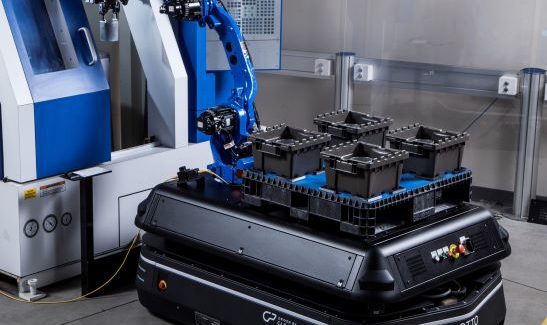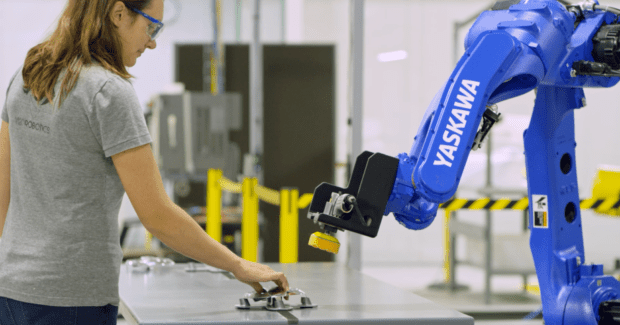Smart Robots for Intelligent Production
Collaborative-style robots combined with mobile robots are increasing shop capability and interacting more freely with their human coworkers.
Posted: July 13, 2021
ADVANCING AUTOMATION
BY ROGER CHRISTIAN
Robotic automation has come a long way from strictly being used in very controlled environments where low-mix, high-volume production was the only viable and cost-effective option for a reasonable return on investment. Traditional industrial robots with complex programming and physical protective barriers have given way to easy-to-program and re-deployable collaborative robots (cobots) designed to work safely in close proximity to humans.
This collaborative operation is helping manufacturers gain greater flexibility and capacity to fulfill the increase in consumer product variety. Increasingly being used for tasks such as machine tending, palletizing and welding, robots (industrial and cobots alike) equipped to work collaboratively are helping new and highly relevant applications come to life.
On the Move: The Autonomous Mobile Robot (AMR)
A variety of technologies can be combined into a single system to complete tasks with a high degree of skill and autonomy.
Growing in popularity to meet production needs in dynamic factory and distribution environments, robots equipped with light detection and ranging (LiDAR) sensors, vision systems and custom end-of-arm-tooling (EOAT) are being mounted on highly flexible autonomous mobile robots (AMRs): robotic platforms capable of maneuvering through a facility to perform a task. This efficiently and safely facilitates jobs such as picking and sorting as well as on-demand material transport.
More recently, with COVID-19 protocols in place, AMRs are being outfitted with “disinfection robots” to deep clean potentially infected areas such as doorknobs, handrails and other high-touch surfaces.
These mobile robotic platforms make it easy for manufacturers to redeploy industrial and collaborative robots around factories and warehouses, as needed, to help with machine tending tasks and other applications where having a dedicated robot doesn’t make sense. Aside from freeing human workers to focus on more value-added priorities, AMRs equipped with a single- or dual-arm robot enable multishift operation, minimize manual product transfer damage and optimize product workflow to meet upticks in processing demand.
Conversely, stationary robots equipped to work collaboratively are facilitating the loading and unloading of items on and off AMRs. Using robots in this way helps to quickly, accurately and ergonomically handle products for organized material transfer and consistent throughput of goods.
Collaborating Is Safer and Easier Than Ever
To increase the safety factor and reduce the learning curve for robot programming, dedicated efforts are being placed on the use of artificial intelligence (AI) and advanced 3D vision technology in conjunction with collaborative modes such as speed and separation monitoring (SSM).
In doing so, companies like Veo Robotics in Waltham, Mass., are reinventing the way products can be manufactured by making machines more responsive to humans. Using computer vision and 3D time-of-flight sensing on a browser-based app that runs on a standard PC, the FreeMove system gives standard industrial robots the ability to perceive and respond to their surroundings so they can work safely alongside humans. That means manufacturers who’ve invested in industrial robots don’t have to spend more money for a safer — and slower — cobot.
In addition to providing an option that safely allows for human workers in the production equation, systems like Veo’s FreeMove can help manufacturers better adjust to mass customization, shorter production runs and tightening quality demands, making it more cost-effective in the long term.
Helpful Resources for More Information…
If one thing can be said about the increased use of collaborative-style robots combined with AMRs (whether the robot arm is on the AMR or loading/unloading its payload at a fixed location), it’s that manufacturers that effectively implement these tools should expect a greater ability to rapidly scale up and down during periods of demand volatility.
With the smart robots market projected to grow at a compound annual growth rate (CAGR) of 30.5% between now and 2025, company leaders would be wise to learn how these technologies could improve product quality and operational efficiency to gain a competitive edge.
Decision makers interested in knowing more should reach out to an experienced robot supplier or integrator. As always, a thorough risk assessment of any robotic application should be conducted before implementation.
Similarly, joining the ARM Institute may be beneficial. (ARM stands for Advanced Robotics for Manufacturing.) A U.S. Defense Department-sponsored consortium of more than 275 organizations from industry, government and academia, the institute strives to strengthen the U.S. manufacturing sector by making robotics, autonomy and AI more accessible to manufacturers large and small and preparing employees to work effectively with robotic technologies. For more information, visit www.arminstitute.org.

















